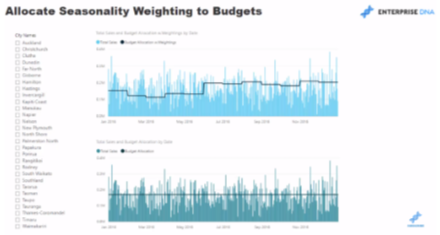
Seasonality is one of the major culprits in the highs and lows of most businesses. This can be due to holiday periods, events, seasonal climate, and so on. This could greatly impact the profitability of the business. The key to getting through this is to prepare an effective seasonal budget. One of the most efficient ways to accomplish this is by using Power BI.
Carrying out a budgeting analysis in Power BI is not that easy. That is why I put together this blog post, which includes some of my budgeting and forecasting tutorials, specifically on seasonal budgeting. What I show in the video tutorials are probably some of the most advanced techniques that you can get to with budget analytics. In these tutorials, I demonstrate how to incorporate some seasonality into your budgeting numbers.
In the first tutorial, you will learn how to use variables as well as the data model effectively to integrate seasonal allocations to your budget in Power BI. I cover many advanced DAX concepts in this tutorial, including the use of CALCULATE, ALL, VALUES functions, and more.
There’s a lot to learn in this detailed tutorial. Note that budgets are never allocated uniformly or consistently in a linear manner throughout the year. For instance, you have yearly budgets and you need to create a budget allocation. You can’t allocate a budget evenly for each day because some months will have higher or lower sales over holidays or the summertime, for example, or periods with promotions that you may have run. In this tutorial, I walk through how you can manage this seasonality.
The scenario that I go through in this tutorial shows how to allocate yearly budgets across each day as well as seasonal weightings per month. You’ll learn how to measure your yearly budget against a daily actual and a monthly actual. You’ll learn how to distribute it to different weightings for each month.
If you want to learn more about the technique in seasonal budgeting on a monthly basis, check out this next tutorial. Here, I work out a way to allocate calculations across different months.
Budgets are mostly done on a yearly basis but narrowing it down to a monthly basis is so much better. I demonstrate a few nuances of how this all works in Power BI with some advanced DAX calculations. The main formula I cover in this tutorial is with the TREATAS function, which creates a virtual relationship. I utilize a supporting table to allocate monthly Budgeting Sensitivity.
Now, how about automatically creating budgets with a seasonal impact? Yes, you can do that in Power BI and that’s what’s this next tutorial is about. Learn how to automatically create forecasts that incorporate a seasonality aspect in them.
This technique is something specific and quite advanced on budgeting through Power BI. I demonstrate how you can pick up the sales from the previous year but then add considerations to anything that could affect the numbers. It’s easy to get that seasonality impact from historical information. You can see the changes in your business over certain periods. And that’s what you’ll accomplish through the formulas I demonstrate in this tutorial.
Key Take Away
Budgets are often at a different granularity. You’ll have actuals daily and your budgets are on a monthly or yearly basis. Budget analysis is not easy, and seasonality impact makes it more complex. In this blog post, I share with you advanced budgeting and forecasting techniques, specifically with seasonal adjustments that you can use in Power BI.
If you’re a seasonal business, this will be very useful for you. This set of techniques has great potential as it gives you a highly effective analysis. It enables you to automate your budget analysis and get some amazing insights at the same time.
The key is to understand fully how the DAX functions work, when to use them, and how to combine them in a formula effectively. Furthermore, to integrate such logic inside Power BI requires you to have a strong understanding of the data model. If you can learn to create the correct DAX formulas for this analysis, you’re on the right track.
***** Related Links *****
Budget Allocation: Monthly Forecasts Across Daily Results In Power BI
Create A New Table In Power BI: How To Implement Budgets & Forecasts Automatically Using DAX
Compare Actual Results to Budgets Using Power BI Forecasting
***** Related Course Modules *****
***** Related Support Forum Posts *****
Budget And Seasonality For Each Month
Incorrect Budget Allocation With Weighting
Derive Daily Budget Figure From Monthly Budget Data
For more seasonal budgeting support queries to review see here….




Be the first to comment